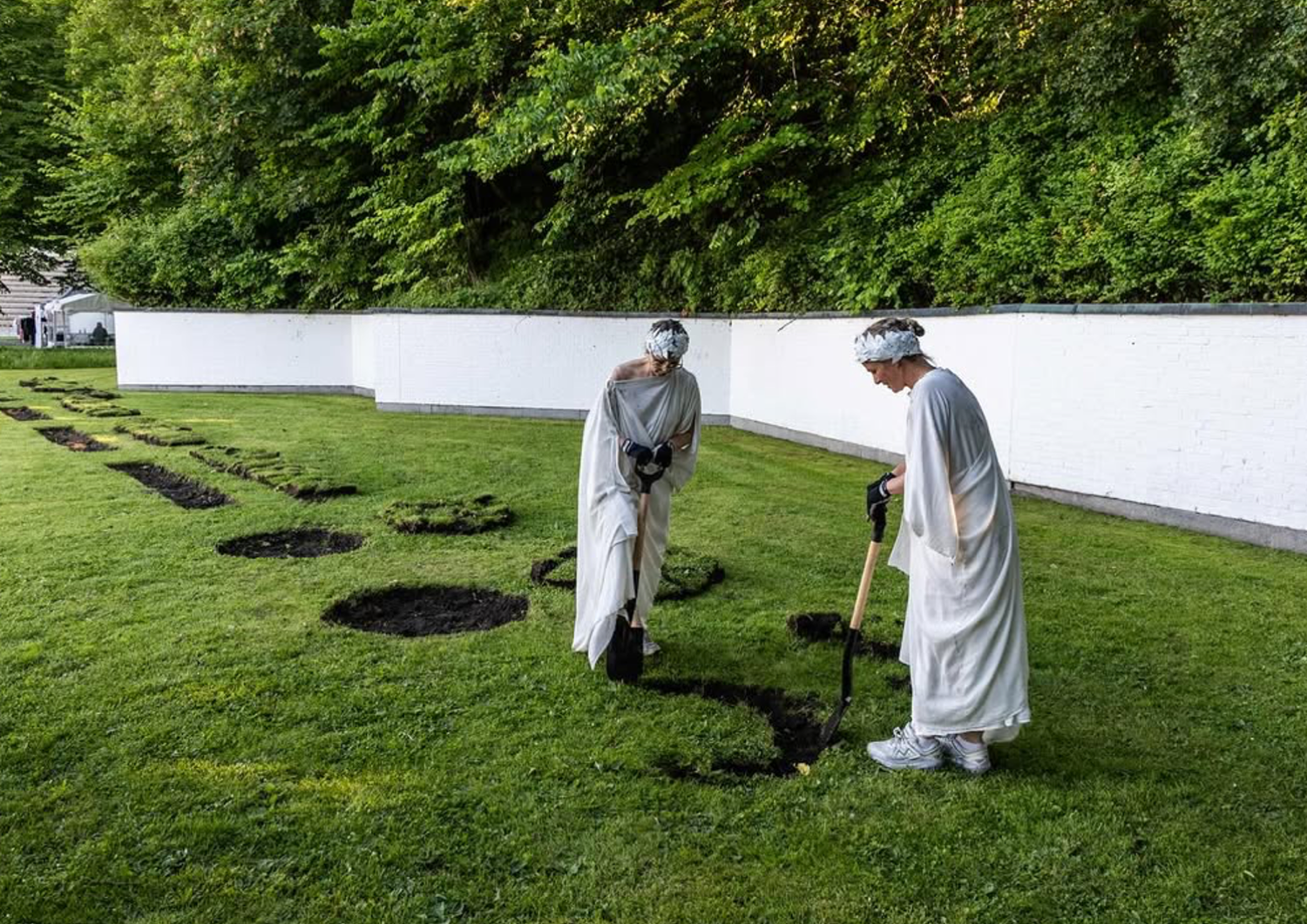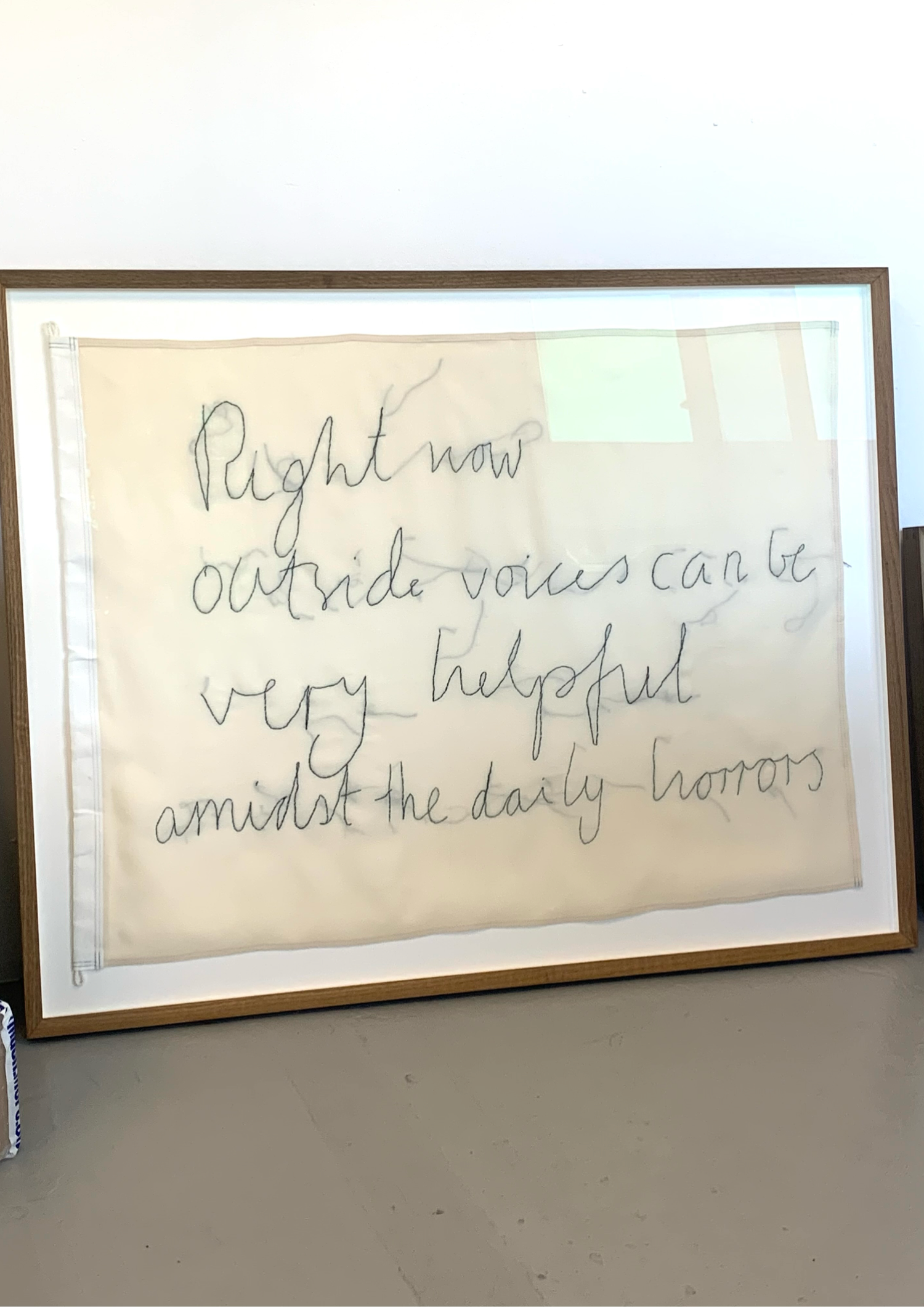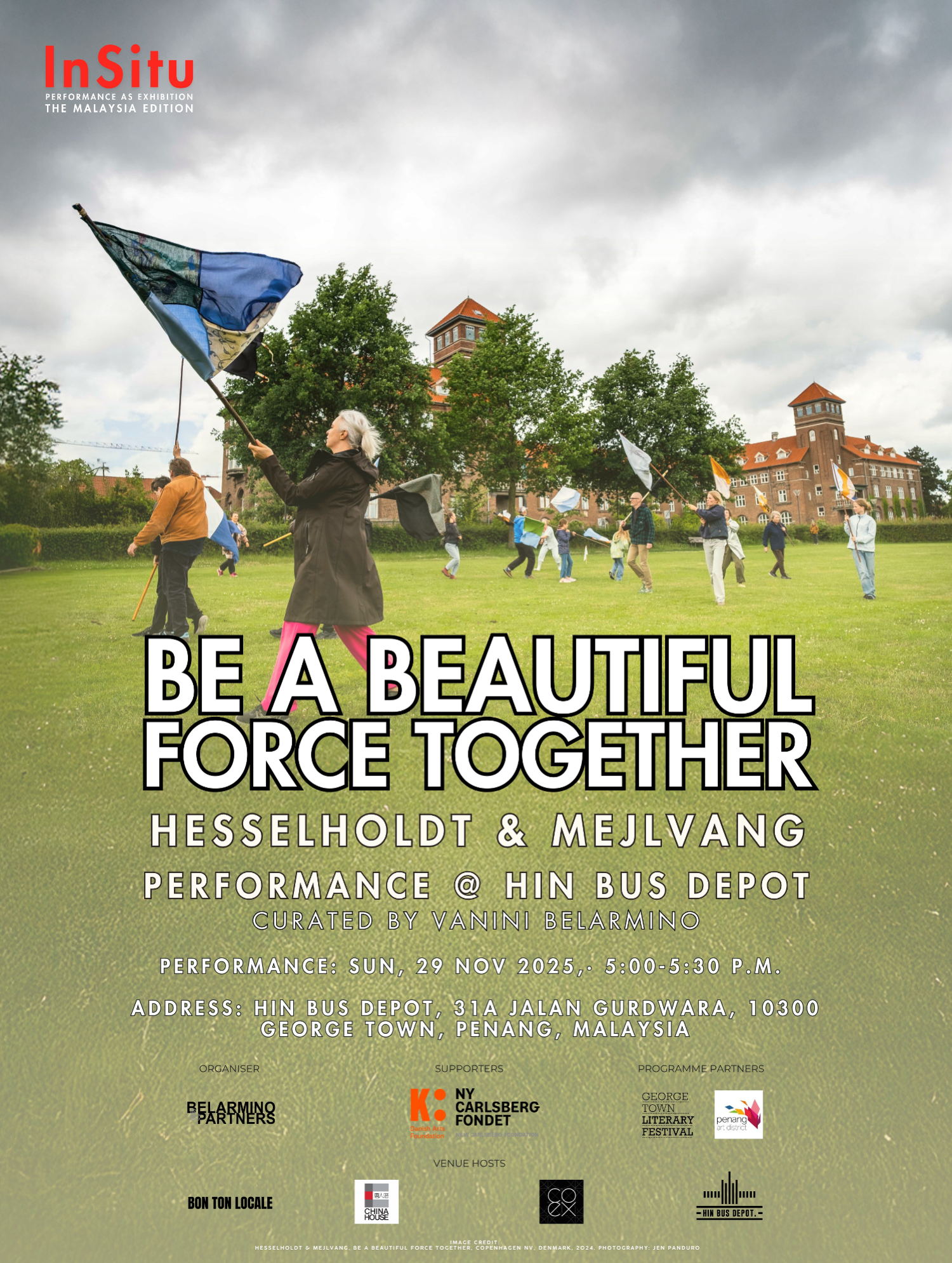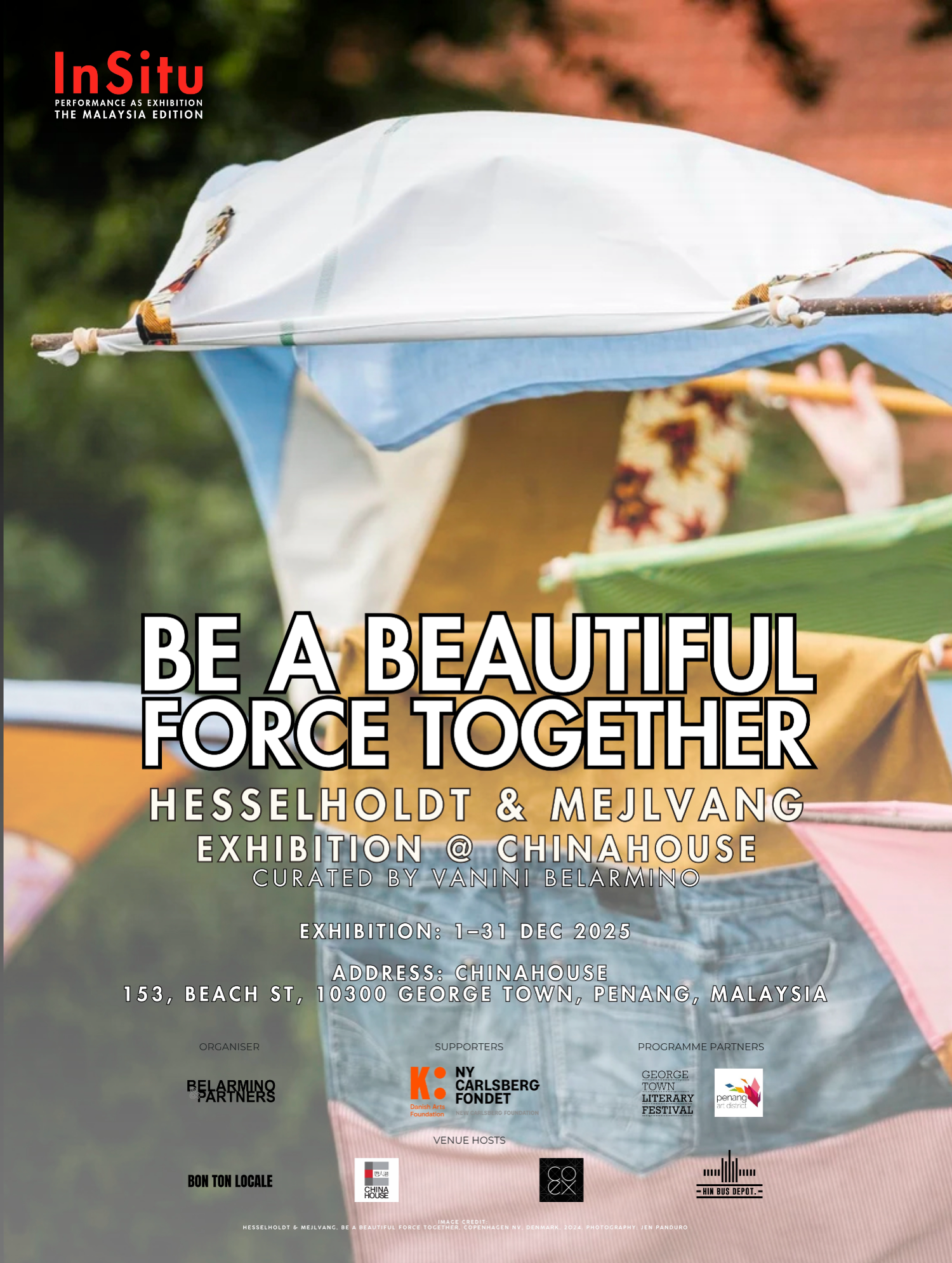Words and interview Vanini Belarmino
Images Vanini Belarmino and Hesselholdt & Mejlvang
Hesselholdt & Mejlvang, the Danish artist duo formed by Sofie Hesselholdt and Vibeke Mejlvang, have developed a distinctive practice that encompasses installation, performance, and social interventions. Working together since 1999, their collaborative journey is characterized by an ongoing exploration of identity, collectivity, and the power structures embedded within cultural symbols. Through a highly visual language that often employs textiles, flags, and staged actions, they create works that provoke dialogue and invite audiences to reconsider familiar markers of belonging and difference.
For In Situ, Performance as Exhibition, The Malaysian Edition, Hesselholdt & Mejlvang will present Be a beautiful force together. Engaging directly with the public, the work extends the duo’s long-standing interest in performance as a catalyst for connection, creating spaces where audiences are not passive observers but active participants in shaping meaning.
In this conversation, curator Vanini Belarmino explores the origins of their artistic duo, their transition from classical studio practice into performance and public engagement, and their recurring use of flags and textiles as symbolic materials, as well as how Be a beautiful force together is envisioned to resonate within the Malaysian context.
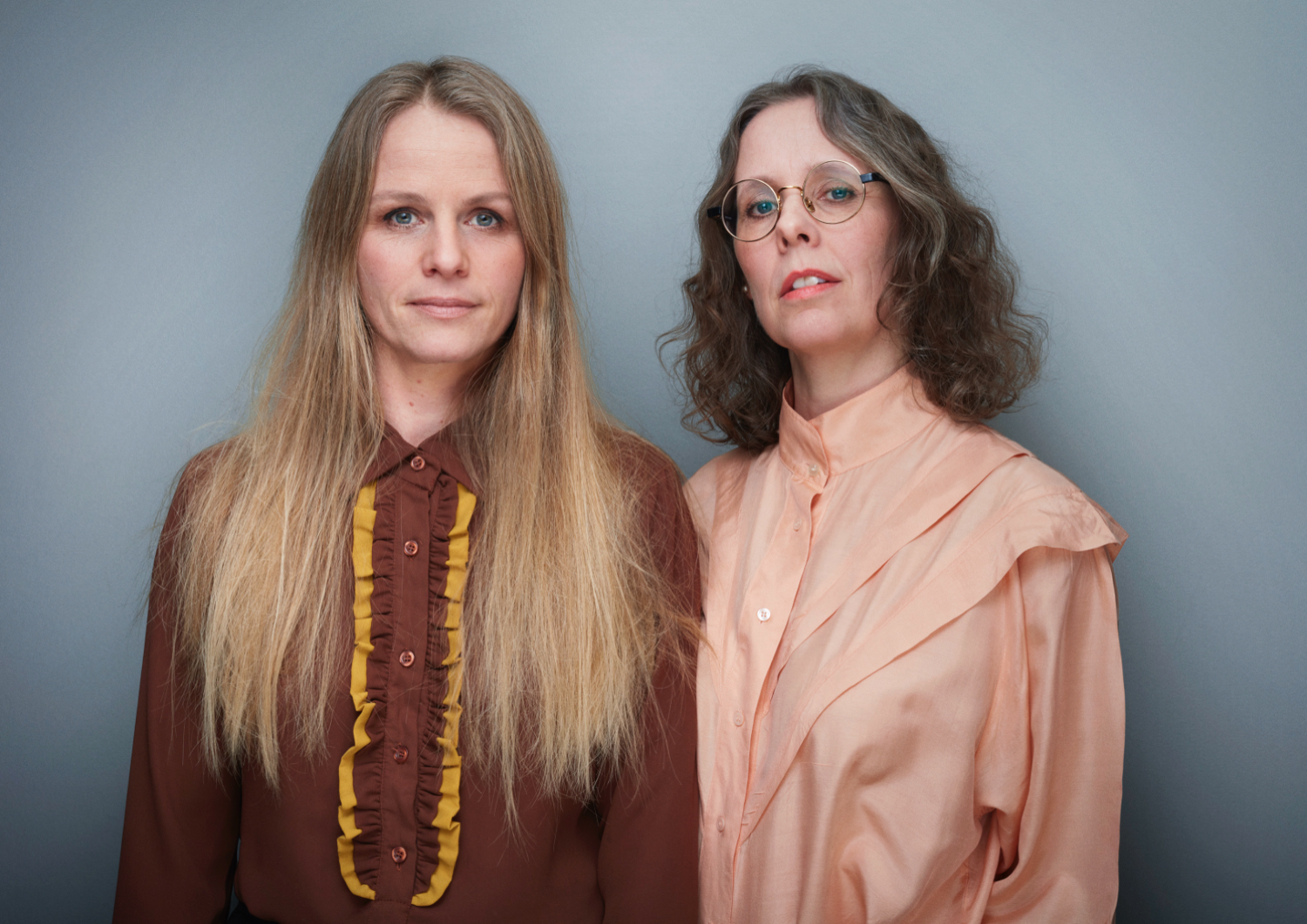

Vanini Belarmino: Sofie and Vibeke, I’d like to ask you about your beginnings. Could you take me back to the early days of your collaboration? What brought you together, and how did your shared interests shape the foundation of your practice?
Mejlvang: We started in the Funen Art Academy in Odense, another part of Denmark, and our studios were next to each other, so we started talking, and, you know, at that time, it was about all the guys in the academy. We both needed a friend, since we didn’t know anyone in Odense. That’s how we started, that there was this connection between us, that I wanted a friend. I asked for her telephone number the very first day, which was in 1999.
Sofie applied to the Royal Academy of Arts in Copenhagen the year after I did. I also tried, but I didn’t get in. So I reapplied the following year, and then I was in Copenhagen. We graduated together in 2006. But in Odense, I think, after just three months, we already held our first exhibition together in the academy space. I think all the older students were like, “No, you can’t do a show already,” since you just started, and so on. But we believed in it, and we did it together, having so much fun. The very first exhibition was called “Go Construct.” I think there was a lot of fun and humour between us, so it was easy to put on that exhibition. And from there, we just became a group.
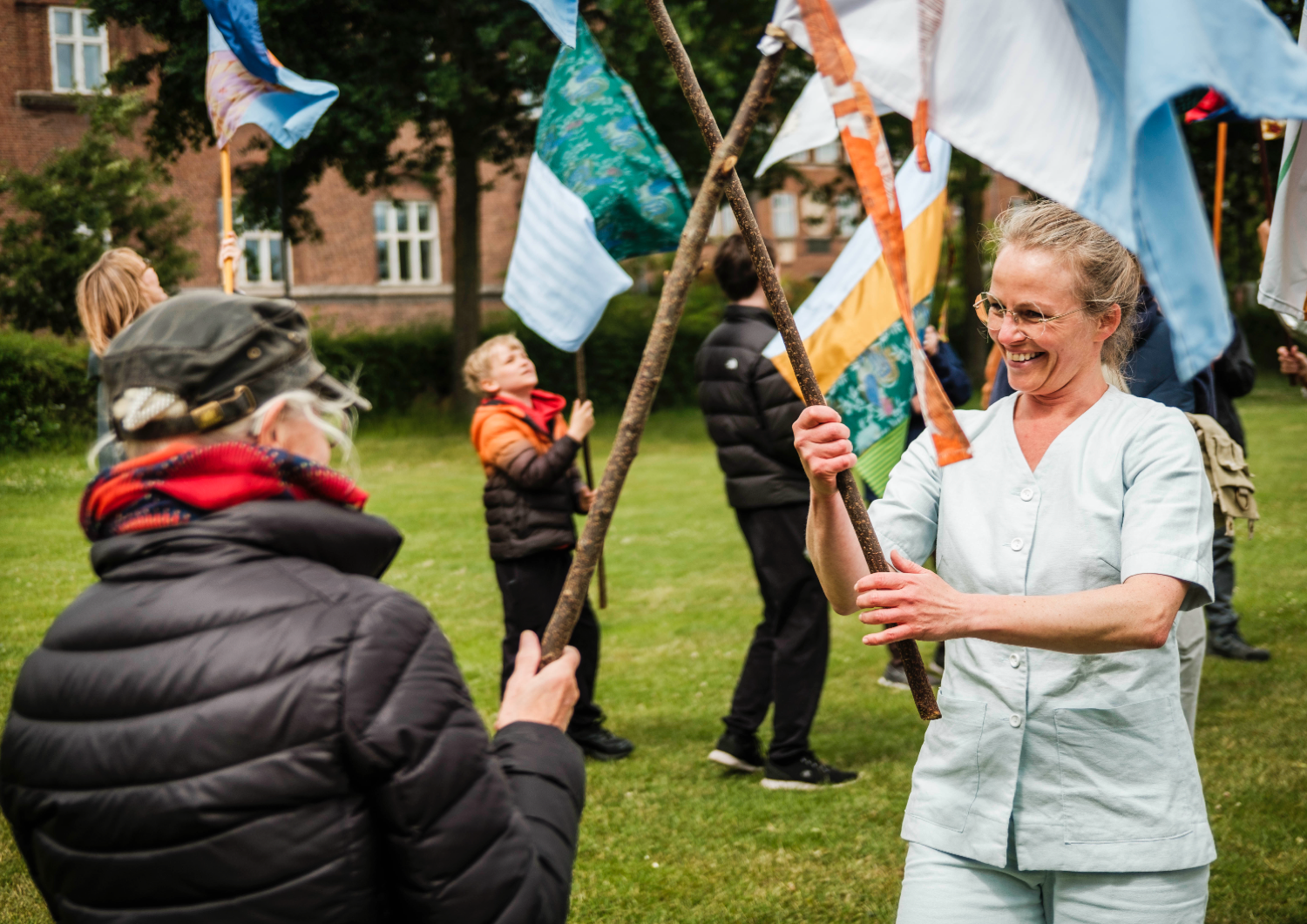

Did you practice independently before deciding to work together?
Mejlvang: We were both very active before, doing our own projects before the academy. Sofie had a studio in Copenhagen for years before you entered the academy. I attended some art schools in Denmark.
Hesselholdt: Yes, but I had quite a lot of exhibition activity even before going to the academy. I was a bit older when I started and also held a bachelor’s in art history at the time. We each had our own practices; Vibeke was making sculptures, while I mainly focused on painting but also explored installation, objects, and so on. We just had an instant connection. Additionally, we were very interested in politics and life in all its various aspects. We shared a very strong bond.
SH: That was around 2000, and it was actually in a public space. We spent the initial years engaging with public space. Interventions in public toilets and shop windows can spark this creative energy by asking shops, “Can we do a project in your shop window?” Can we do something here? We had so much energy that we launched many public space projects right from the outset. That was also something we shared — this genuine interest in going where people are, where their daily lives unfold and where art intersects with reality and the real world. That has been with us from the very beginning.
Additionally, we have a deep interest in society, conflicts, and how politics influence daily life. From the beginning, it was a blend of something poetic as well as various aspects of politics, power, and identity that we still explore today. These elements were established together from the very start. When we reflect, and we do so quite often now because we’ve created a new website with an archive and are planning a show at the SMK – Statens Museum for Kunst next year in Copenhagen, which will also be a retrospective, we see that we are quite similar to how we started, just older. You can trace many aspects back to the very beginning.
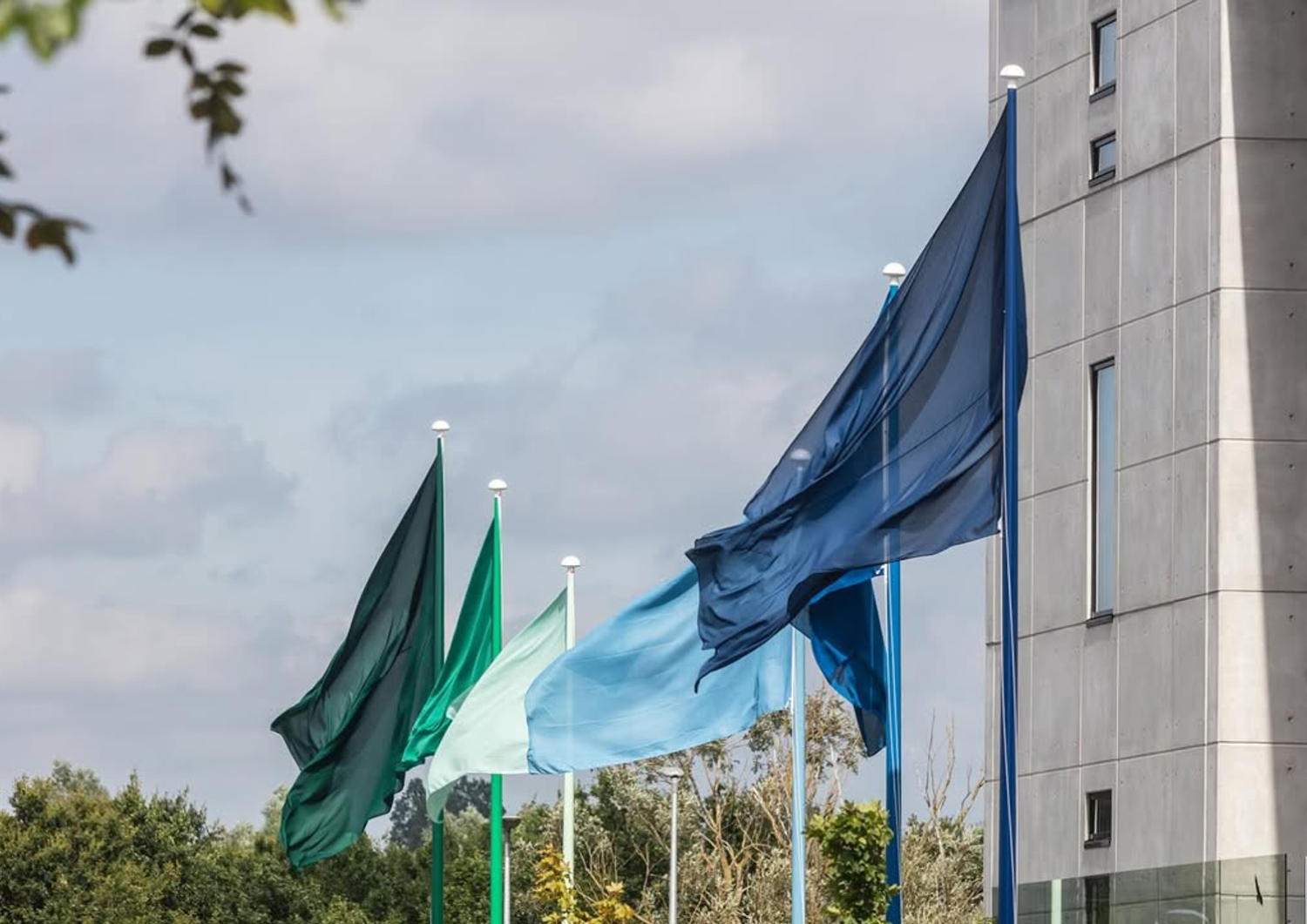

It’s amazing how you found each other and to have that connection. During this time, it wasn’t very common to do things in public spaces and with Denmark having a lot of established places, what prompted you to work in the public space? Of course, apart from having a lot of energy, there are many younger artists.
Mejlvang: We were young and not many places invited us to exhibit, so we decided we had to do it ourselves. We rented this bunker the year after renting another park, temple, and other venues. We couldn’t wait to be asked, so we took the initiative to go out there. Twenty-five years ago, there weren’t many open calls. There were spaces, including artist spaces, but not that many.
Hesselholdt: Not if you were a student, it was difficult.
Mejlvang: And I think for us, it was very important to have this experience, to do all of it ourselves—creating the flyer, organising the press, and going out to declare it’s our space and we want this. Now, we have an exhibition planned for next month. We are funding it ourselves, and in doing so, we also ventured into parks where you wouldn’t usually encounter art; perhaps you’d see old sculptures or similar. But to create our installation and crazy projects, we really enjoyed being out there where no one else was at that moment.
Hesselholdt: I come from painting and art history, studying all the old masters. I had this moment, where I felt I couldn’t live up to all the great art created over centuries. For me, moving into installation and public space was a form of freedom because many artists had worked in public spaces since the 1960s. It still felt like a setting where we could define what art was. We could decide what the right thing to do was because there wasn’t the heavy burden of a thousand years of work with installations and interventions in public spaces, compared to painting. The history was relatively short, which I found liberating—it allowed us to tap into our curiosity and genuinely shape things ourselves. We could be part of defining what art in public space is, and I found that incredibly interesting. As Vibeke said before, it felt important to do it.
And we had each other, and that was really special because whenever you do something a bit risky, you always have a companion or someone to share all the anxiety with. That’s also something that’s been with us all along—that we are like this, almost an old couple, genuinely having each other’s backs in many ways. From the very beginning, we used it as a kind of safe space, knowing for sure that Vibeke would never want to betray anything, and I hope she feels the same.
Mejlvang: It was also about going out to meet people on the streets rather than in the museum. Of course, we have done many museum shows and exhibitions at Kunsthalle and similar venues. However, I find, and still do, that it can be more exciting to undertake a project in public space, with a flag or other visual elements. It’s riskier and more thrilling—this encounter with the audience. I do like museums, but organising a museum show feels confined; you know how the audience moves through and interacts with the exhibition. Meeting people in the streets or parks excites me more, and there’s a kind of itching feeling inside to do that.
Hesselholdt: It also sharpens your way of communicating because, if you meet people who are not from the art world, you really have to stand up for your art; you must be able to articulate it. They ask, ‘But why is that? Why is that art?’ or ‘why do you do this?’ and you have to explain. I think we enjoy this kind of communication with the public — very straightforward and down-to-earth. When you’re within an art institution, you mostly communicate with a group of people interested in art. That’s another kind of communication, which is also interesting but different. So, I think from the very beginning, we had this feeling of reaching out. For me, art should matter. We want to change the world gradually. We don’t think we can achieve that solely within the museum — perhaps a little — but when we engage with people outside, meeting them and using the language of art directly, it somehow feels more meaningful to me.
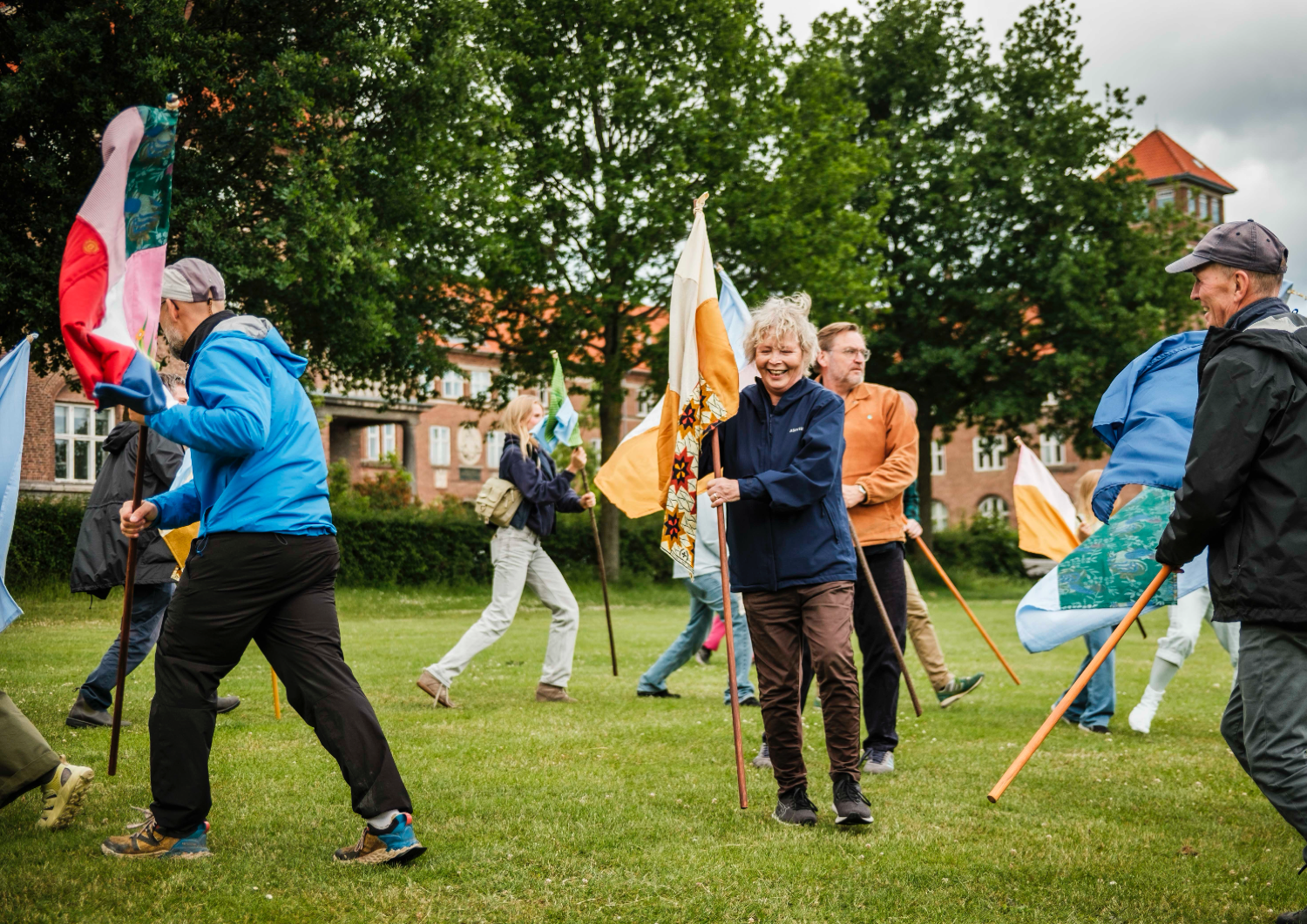

What has been your most rewarding experience being in the public space?
Mejlvang: My first thought was about a flag project we did for the Roskilde music festival one summer, which was only for that week’s festival. It consisted of a circle of flags and flagpoles. The poles varied in height and colour. It was a challenging art project because it explored skin colour and societal layers. During the festival, it became a meeting point: a place where news from the circle was shared and people gathered to sit, chat, and do yoga in the mornings. It was simply a circle of flagpoles creating space amid the lively festival environment. I think that was a special one. This art piece has also travelled around Denmark, holding a special significance. I don’t quite know what it is about, just a circle with 12 flagpoles and flags, but it created a space in the public realm — its own little spot, you could say.
Hesselholdt: I find it difficult to highlight one element, but I also consider the other performances we undertake in public spaces. We have engaged in various durational projects, such as digging for three hours or moving 500 old tyres to build something. There’s also the experience of Be a beautiful force together, where we connect with people. The sense of connection I feel as a performer outside is very meaningful. I feel deeply connected to the earth, my surroundings, and the participants.


How did performance come about when you started working in the public space?
Mejlvang: Actually, we explored this very early in art school. I recall a performance I did in my first year, so I believe it has been on our minds for many years. We also ran some tests and made a video piece where I was running through the forest in a ghillie suit, which we were also considering at the time. We attempted to do some of it, but for many years, it remained just an idea we didn’t pursue further. However, we constantly discussed the audience as a vital part of the exhibition. Like in an installation, you need the audience to complete the experience. When we created an installation ten years ago, it was always about how they would move through the space, up and down, and all the interactions involved. The audience has always been a crucial element. Later, we worked extensively with skin colour, and then it became clear that we should try to work with real skin and real people.
Hesselholdt: I might add to this because we’ve done many of these installations over the years. They were always empty spaces. We made rooms—empty rooms. We imagined that a group of people had lived in this space. They created it and then left again, so we crafted very scenographic installations that looked as if someone had been there and left traces. However, we never actually had real people in those spaces. Gradually, we felt that perhaps it was time to put real people inside them. That was the progression towards creating genuine performances. Then, around eight or ten years ago, we started doing more performances. It made so much sense that we have focused greatly on that since then. I think I even wrote something just before that, which I need to remember. What I like about performance, and what makes sense in our practice, is the presence you truly feel during a performance. Of course, you can have objects and installations; that’s another kind of presence. But in recent years, we have worked a lot with hope and connectivity, and this positive feeling has been a counterpoint to all the conflict in the world. So we also try to do good things or focus on what is good in the world. For me, creating a performance is very much about connecting with the audience. It’s terrifying for me to go on stage.
I remind myself that I am putting my trust in the situation, in the love from the audience, and in my surroundings. For me, to love and to trust are the main themes when I perform because it makes me vulnerable. It’s extremely delicate. You lose control. And that tense feeling—since we’re not actors and haven’t received professional training, we learn everything ourselves—makes it even more raw. I go on stage simply as myself, and I find that very vulnerable. But that’s also what I love about performance: the intensity and presence in the moment, where we are here and the audience experiences it with us. So, all our ideas about connection and togetherness are embodied in the performance itself.
Mejlvang: It’s about sharing. I was thinking about when we performed Be a beautiful force together here in Copenhagen. And you don’t know who, which people are coming, and whether they would be part of it, and whether they would play with us? After walking around with the flagpole, they manage all the choreography and so on. We, in the very end, share the flags. We pass the flag to one another, then exchange it for a new one, and so forth. That moment meant a lot to me. It was, you know, a special moment because we had done a lot with the flag. It was like marching, having fun, stitching, and many other things. Then, when we shared that moment and the music was playing, it felt almost magical for me, and you could see it in people’s eyes. It was truly a very touching moment. There was this old lady I remember—she was having so much fun, and so was I. We shared a perfect moment of connection. That was all we could hope for.
Photos from Hesselholdt & Meljvang studio
You trust and respect each other, and you extend that to your audience. That’s very brave, especially since you mentioned feeling vulnerable. Out of curiosity, because I was looking at your artist book, where does the interest in conflict come from? Because, of course, you read the news. You mentioned how politics impact society. This is a reality for everyone, but your immediate environment is relatively safe and somewhat peaceful compared to elsewhere. Also, skin colour is slightly related to that, particularly regarding migration. Would you like to share a bit? I’m curious to hear more about this.
Mejlvang: I know that if I were not an artist, I would be a social worker. So, it really reflects how I see myself in society if I weren’t an artist. I might have worked in a conflict zone, you know, or with people on the streets. So, for me, it’s just, yes, it’s so clearly a part of our art.
Hesselholdt: And I can add that if I weren’t an artist, I would be a journalist. Although Denmark is a very safe place, I agree with you. I feel genuinely safe here, but I also believe we both have a strong openness to sense what’s happening in the world. This quite influences me. I read the news extensively every day, so I’m not interested in what’s happening solely in Denmark. I care about the whole world and what is occurring everywhere. Of course, I don’t suffer myself, but I try to stay informed about different places and sense some vibration or atmosphere. It’s a sensitivity to the world, in a way. The world is far larger than Denmark, and my children should grow up within this global context.
Climate change also impacts Denmark, and we are interconnected. If there is a war in Ukraine, we will accept Ukrainian refugees. We influence each other and discuss this often. For example, we are currently working on an installation for the National Art Gallery in Denmark (SMK) about the European Union, which faces significant pressure from various factors, including Trump, the ongoing war in Ukraine, the Gaza conflict, and other issues. We feel this pressure in new ways, and I notice it regularly, even if it isn’t part of my daily routine. When I read the newspapers, it’s everywhere. Trump wants to take Greenland, which is part of the Kingdom of Denmark, along with other territories. It all seems interconnected, which is why we are attuned to these vibrations – if you catch my drift.
Mejlvang: Yes, we recognize the conflict, and I believe that if there is something you can do in your life while you’re here on Earth, you can manage it. Perhaps it is because we feel safe that we have the energy to focus on the negativity.
Hesselholdt: Before the war in Ukraine, in 2018, we undertook a very positive project in a public space in Ukraine. They told us, ‘Oh, it’s so lovely that finally some artists can come and do something uplifting and highlight all the things we have in common in this country, which is very diverse and already conflict-ridden.’ So, it’s not because we need to work directly with conflict, but it is always very present in our minds. I think we’re simply tuning into what is happening, actually.
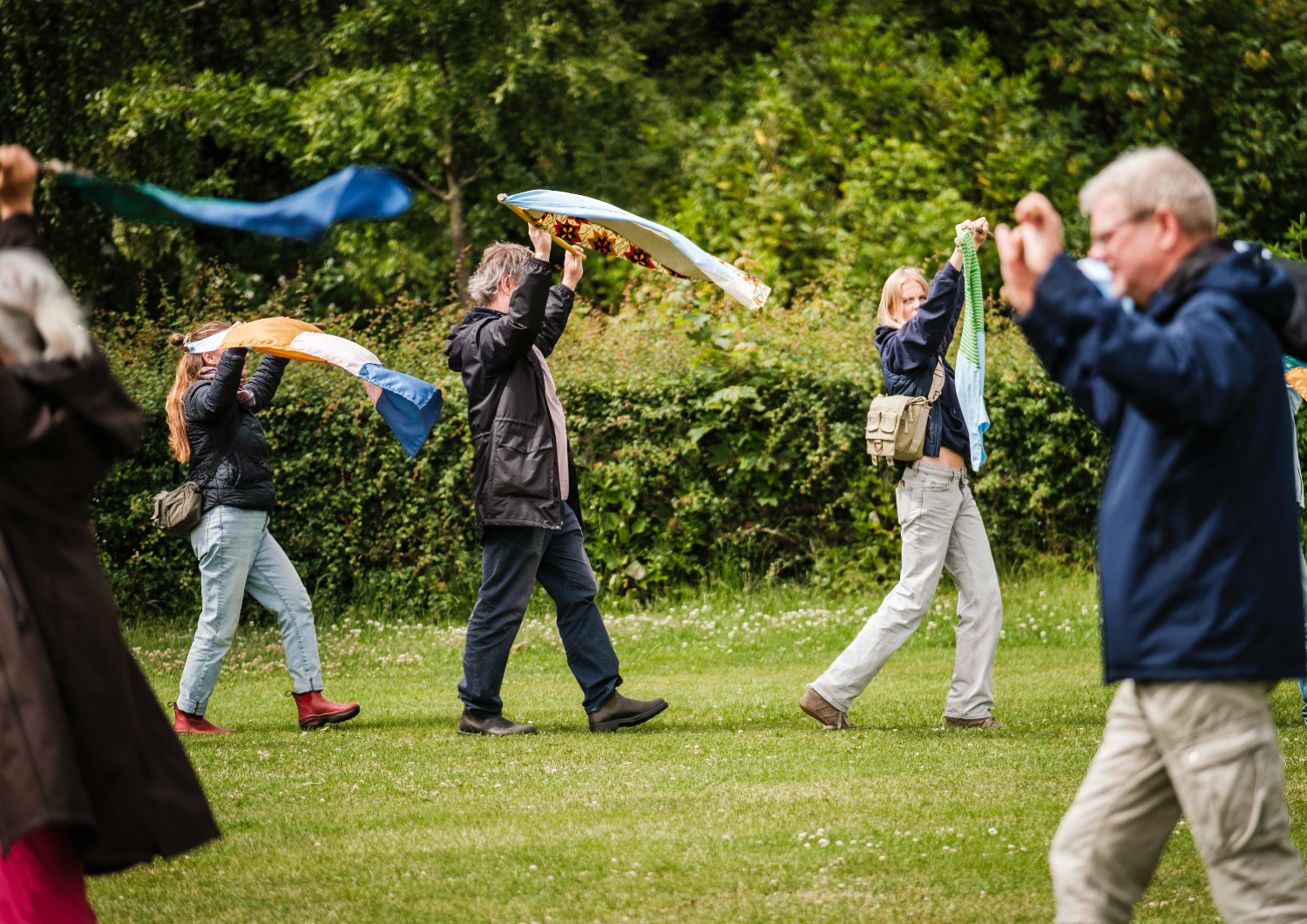

How did you start working with this textile and flags, and what does it mean to both of you?
Mejlvang: And it also traces back to the late 90s, when a rather unpleasant political party called the Danish People’s Party (DPP; Danish: Dansk Folkeparti, DF) emerged.
Hesselholdt: It was a political party, a very right-wing party.
Mejlvang: And that was just a starting point, I think, because they took the Danish flag, which is a red and white flag that the Danes are very proud of, and incorporated their logo. They exuded an attitude of not wanting to welcome outsiders. That was the starting point for us. They took the Danish flag and used it in their logo, which we couldn’t accept.
All this in a mix was like too much, so we had to make some statement about it. We painted the Danish flag black. So, that was the starting point. Very early on, we could sense that people were confused by this piece, feeling that the national flag was imbued with so much emotion. And so that was the starting point of trying to take the flag into our practice.
Hesselholdt: It was also when we started working with flags that we realised how many feelings people have about them. We then became very interested in the flag as a symbol, representing a nation or a group of people. It was aligned with many of our areas of interest, including power, affiliations, belonging, identity, and other related topics that we cared about. The national flag is very inclusive of the people within the nation, but it is also exclusive of everybody who’s not part of the nation. The essence of migration and refugees is encapsulated in the flag.
Over the years, we have started working with flags that welcome everybody, discussing other communities and the ideas that bind us together, highlighting what we have in common rather than what divides us. So, the flag was a natural fit for us to work with.
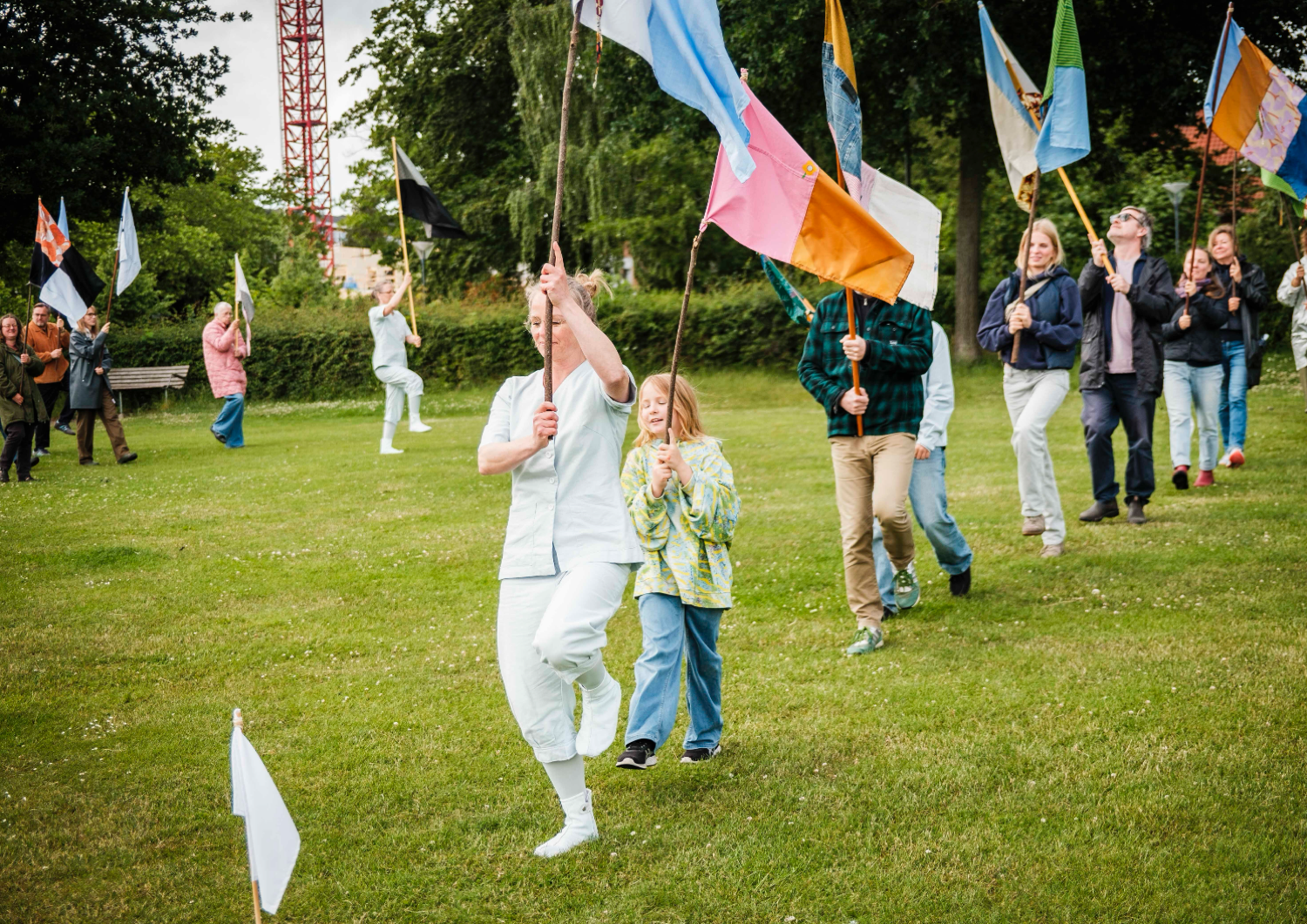

You were talking about what unites us rather than what divides us, with this flag, and how much feelings or perhaps emotions are tied to the flag. I wanted to ask if you’d like to elaborate more on Be a beautiful force together. Why this project? What is the story behind it?
Hesselholdt: It started with the Ukraine billboard, Points of Unity 2018, where we aimed to find slogans that could eventually appear in the public space in Kyiv. Initially, they only had images. Then, after about a month, the slogans appeared on the billboards. We visited a country deeply affected by conflict, revolutions, and political tensions. We visited there twice—first for research and then to execute the project. It became clear to us that we wanted to do something meaningful. I don’t recall exactly how the phrase Be a beautiful force together originated. Still, it was about connecting with a sense of beauty—not literally, but more as an abstract concept.
We wanted to remind people of their power; when they stay united, they can be a force, and this unity is genuine. But if everyone turns against each other, everything collapses. For us, it’s about building up, creating beauty through togetherness, joining forces, and collaborating. That’s what I believe the phrase is about.
Regarding performance, we prefer to reuse our titles, slogans, and objects, allowing them to circulate within our practice. We can take something from ten years ago and reuse it. This method allows these elements or sentences to remain integral to our work. We developed the performance for the Copenhagen project here in the northwest part of Copenhagen, which is perhaps a poorer area of the city. There are social tensions there as well. For us, it was also about connecting with local residents.
Mejlvang: Copenhagen North West is also a part of the city where many people from around the world live side by side. So, this was also part of it. We were part of a local group of people interested in art. Our task was to develop an art strategy for this area of Copenhagen. It all took place in a public space, and we were asked to organise both a workshop and a performance, which led to this idea. For us, it was about all these people from different parts of the world living together. We wondered how to create a workshop that made sense for everyone, or how we could share our stories and lives. Amidst this mix, we thought of using the word ‘beautiful’.
And what are your expectations? How do you see this unfolding in Malaysia, or specifically in Penang? How are you preparing yourselves? And what else do you expect?
Hesselholdt: We’re preparing ourselves by tuning into Malaysia — reading, researching, and allowing its layers to unfold in our imagination slowly. Of course, everything will shift once we’re there, when we can meet people, listen to their stories, and feel the atmosphere of the place. From what I understand, Malaysia, and Penang in particular, is a fascinating confluence of cultures — shaped by Malay, Chinese, and Indian heritage, as well as its colonial past. It’s a place where histories overlap and coexist, where time feels multidimensional — visible in the contrast between British colonial houses, local shophouses, temples, mosques, and the modern skyline. This interplay of tradition and contemporaneity is something we’re very curious about. We see our role not so much as arriving with fixed ideas, but as tuning in — being responsive, porous, and open to what the place and its people might reveal to us. For us, it’s a captivating place where different eras and influences blend together. I believe it will provide a very interesting backdrop for the entire performance because the surroundings greatly influence us. When we arrive somewhere, we observe shapes, forms, scents, buildings, and people’s appearances. We notice the colours of textiles and more. We gather all these impressions intuitively and channel them into our work.
We would like to bring some flags from the Copenhagen project to Malaysia, incorporating elements from local people into the flags. This will connect Copenhagen with Penang and its participants. Some flags may be from Copenhagen, featuring decorations contributed by Malaysian locals. Once again, it’s about making connections and showing that we share so much in common. Even though you live on the other side of the world, we can still communicate. We can still smile at each other. We continue to have lives filled with joy, happiness, pain, and problems. Essentially, human life is quite similar despite our very different circumstances. I am particularly interested in seeing how this resonates in Malaysia, as it’s a new experience for us. What’s also intriguing is whether this will connect with local people in Penang, or if they will think, ‘What are you doing?’ We will then need to discover how it makes sense within that city.
Mejlvang: Try to be as open-minded as possible. I believe that’s how I prepare myself—to sense the people, the atmosphere, and how we might approach a project like this in the meeting. Maybe it will reveal something new that we didn’t know before we arrived, so being very open to what comes our way is also essential.
Hesselholdt: We’d like to be very much in control before we go, so we will definitely create a very strict plan for everything, but also be very ready to make adjustments. It’s about having some structure. And if it makes sense, we go with that. However, we can adjust our approach and redefine the project as the situation requires. That’s also possible; we’ll do it here. But I think it’s about being in control while also being open. •
In Situ, Performance as Exhibition—Malaysia edition is happening from November 22 to December 31, 2025 in Penang and Kuala Lumpur, Malaysia. Follow Belarmino & Partners on Instagram for more details.
